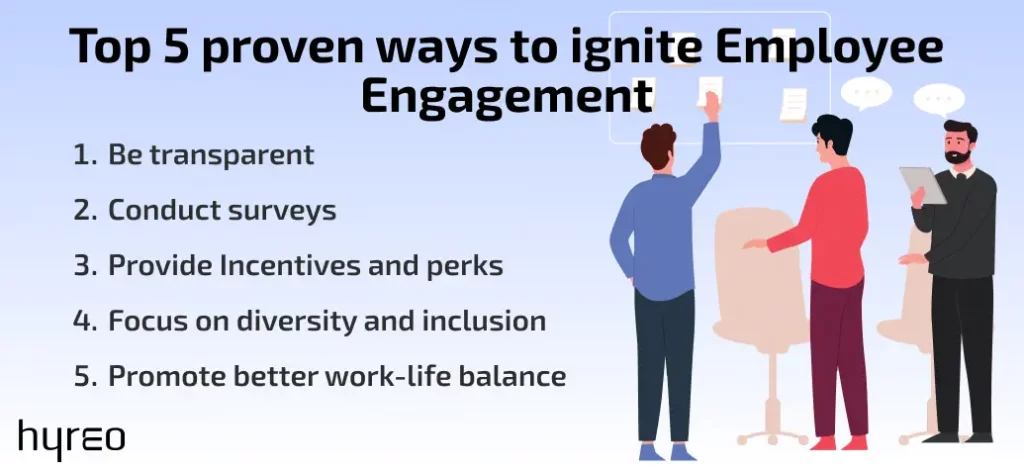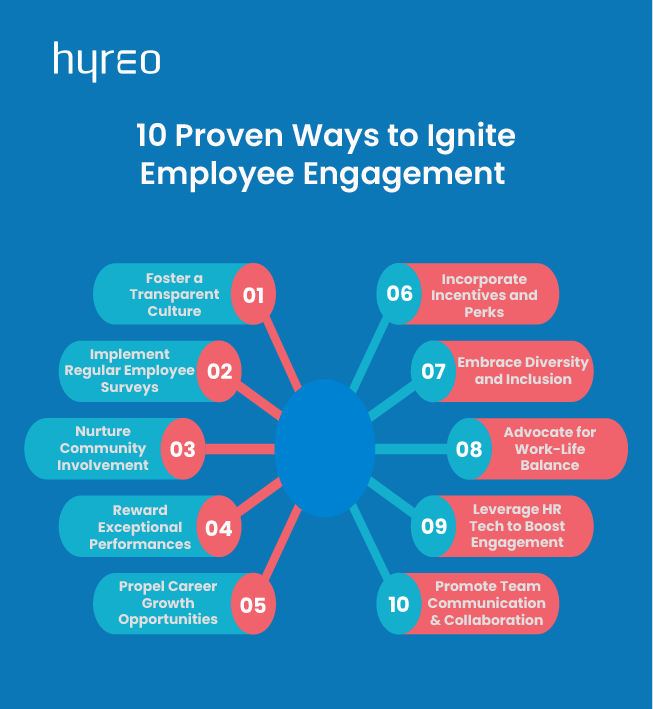Key Takeaways
- Employee engagement goes beyond employee satisfaction to building a motivated workforce that’s committed to the goals of the organization
- Engaged employees bring greater productivity and profitability, reduce costs, and decrease employee turnover and attrition rates
- Organizations should adopt engagement strategies that make employees feel empowered and included in the organization
Disengaged employees are a liability to any organization and cost companies billions of dollars due to lost productivity. The cost of replacing such an employee may go up to 50% of the employee’s salary.
A Gallup study reports that disengaged employees have 37% higher absenteeism, 18% lower productivity, and 15% lower profitability.
The numbers are alarming!
To fix the problem of employee disengagement, leaders need to acknowledge the problem first and take proactive steps to tackle the issues. These steps include multiple employee engagement strategies that can help revive engagement and improve employee productivity and profitability.

What is employee engagement?
Studies suggest that engaged employees bring 21% more profits and 17% more productivity.
But does employee engagement mean just satisfied employees who are given pay raises and perks at work? No, it doesn’t.
Employee engagement can be defined as the degree of motivation and passion an employee feels at work. Engagement involves an individual’s emotional connection or commitment to their organization which motivates them to go the extra mile to perform and remain loyal to their organization.
The more engaged employees are, the better it is for the organization. Engaged employees can be the high-ROI assets for your firm. Engagement drives other benefits like customer retention, reduced employee turnover, better talent acquisition and retention, and a holistic work environment where people thrive and collaborate for organizational prosperity.
Well-engaged employees also entail a lower cost-to-value ratio for the personnel expenditure of your firm. In the 1990s, this idea was introduced by Harvard researchers as the service-profit chain. This idea finds engaged and motivated employees as the starting point for increased business profitability and customer loyalty.
10 Key Proven Employee Engagement Strategies
To build employee engagement at the workplace, HR leaders and managers need to focus on the entire employee lifecycle and develop employee engagement strategies.
Some of the top employee engagement strategies include the following:

#1 Be transparent
The Ultimate Employee Engagement Survey 2019 suggests transparency as the first requisite for building engagement at the workplace. The feedback obtained from employee surveys should be worked upon in the open rather than initiating policies behind closed doors.
A Press Trade Services report found that 85% of the employees felt motivated when the management updated them on the company news and the efforts the leadership is taking to engage them.
Transparency helps in building employee trust. Suzie Finch, the founder of the Career Improvement Club, says, “And when you gain that trust, magical things start to happen—employees develop a true sense of ownership over their jobs, and productivity rises.
Trust also removes that hierarchical divide; it puts everyone on a level playing field, steering and sailing the same ship together as one. Ideas flourish, employees feel engaged and working environments feel uplifted.”
#2 Conduct surveys
HR managers should adopt a bottom-up approach to implement engagement strategies. The best way to do this is by using employee questionnaires and surveys where employees can freely express their opinions and share their feedback.
When change starts at the lowest tier of an organization, it is warranted that employee engagement will see improvement. When expressing their opinions through these surveys, employees feel valued, respected, and that they belong to the organization.
For the managers, the surveys can provide a baseline for the strategic framework for employee engagement. Surveys can be of multiple kinds, including:
- Rating statements according to a given scale, say from 1 to 10.
- Open-ended questions
- Multiple-choice questions
Bob Lehto, Vice President, Human Resources at BRD, an app-based cryptocurrency platform, says, “ Our leadership team ensures employees have regular one-on-one check-ins with their manager. Status updates are handled in stand-up meetings so that one-on-ones can focus on long-term goals.”
The questions in the survey should address the everyday issues that employees face, their interaction with the management, and their overall impression of the company’s mission and goals. Employees should be given a choice to post their responses anonymously.
#3 Encourage community participation and engagement activities
When the employees are considered as a community rather than a workforce, managers can touch up the human element and bring emotional context into play. There can be many engagement activities where the workers are encouraged to fulfill their tasks to serve the community.
While a defined hierarchy is a must for officiating roles and responsibilities, a certain level of unbiasedness and equality in the engagement activities can lead to community building and engaged staff.
Some of the engagement activities can be:
- Fun office games like a scavenger hunt, annual sports event, or monthly trivia game
- Lunch-and-learn initiatives where employees are encouraged to dine together and speak up on an issue they are passionate about
- Celebrations for birthdays, anniversaries, and other milestone achievements
- Theme days where employees are encouraged to dress up or bring a certain kind of culinary, celebrating diversity in all things
#4 Recognize good work
Recognizing good work is one of the top prerequisites for employee engagement. A survey found that 63% of the employees who felt recognized were unlikely to look for a new job. Similarly, 72% of businesses agree that recognition has a positive impact on employee engagement.
Recognizing employee efforts and showing them they are valued can go a long way in achieving the organization’s goals and ensuring employee commitment towards the same.
The recognition can be in the form of rewards like cash prizes, free day off, gift cards, etc., or may include a monthly/weekly recognition program where the top employees are given titles. Subsplash employs a similar engagement strategy where employees nominate members to be the ‘Animal of the Week.’
#5 Provide opportunities for growth
In a CNBC survey, 62% of the candidates were unsatisfied with the support or career opportunities their company offered them.
Employees feel motivated when they work towards their personal goals along with the company vision. When given the opportunity to expand their skill set and improve their career growth and learning, and development, employees feel more engaged.
When a company chooses to invest in its people, it drives employee engagement levels in the organization. For instance, CB Insights offers a $1,000 education stipend to all its employees who have been with the company for six months.
Beyond career opportunities, employees must be given the opportunity to educate or upskill or hone their personalities to help them attain better opportunities in the future. Employees feel committed and loyal to a company that supports its employee’s professional growth via a training program or sponsoring their higher education.
#6 Provide Incentives and perks
Companies need to go the extra mile to make their employees feel valued and special. Office perks and incentives, though age-old methods and often associated with employee satisfaction, can motivate employees to go beyond the bare minimum.
Employee perks and incentives can encompass multiple benefits, including
- Wellness checks
- Education programs
- Gym memberships and discounts
- Office amenities like cafeteria, daycare centers, and shopping complex within the office space
- A thoughtfully designed office space, etc.
Incentives for good work may include bonuses, pay raises, additional vacation days, verbal acknowledgments, promotions, etc. A company that is professionally and personally invested in its employees has lower employee absenteeism and reduced retention rates.
#7 Focus on diversity and inclusion
A Gartner research found that diverse teams saw a 12% performance boost and intent to stay at the job. Company culture should focus on the value of workplace diversity, inclusion, and equality across age, gender, race, and ethnicity.
Moreover, a diverse team is better placed to be an accurate representation of your customer base and is better positioned to yield results and outcomes. Diversity in the workplace isn’t restricted to hiring a team made up of diverse colors, ages, genders, and age groups. It includes equitable compensation, raises and promotions, and valuing all ideas and feedback from the employees as equal.
#8 Promote better work-life balance
Work-life balance plays a crucial part in any employee’s satisfaction and commitment levels. When employees are less stressed or burnt out, they feel more productive and engaged at work.
The hybrid work culture is a great example of a work-life balance initiative. Employees can be encouraged to work from home on certain specific days or opt for flexible work schedules. A generous PTO policy, provision for daycare, or parental leave are the emergent demands that need acknowledging by companies today.
Work-life balance can also be encouraged by promoting policies of non-disturbance beyond work hours or financial wellness initiatives that help employees sort their finances without being stressed. Mental health and well-being are also rising concerns that companies should address while formulating their engagement initiatives.
#9 Utilize HR software to improve engagement
Leveraging the capabilities of HR software like ATS and CRM may prove a far-fetched idea to engage employees. However, a little insight into how HR software utilization can yield engagement can be powerful for organizations seeking to motivate their employees.
By automating and streamlining processes like payroll, benefits management, attendance tracking, etc., HR software can help HR staff to reduce their manual burden and focus more on creative tasks and jobs they are best at. More freed-up time also means more time for engagement and fun activities.
HR software programs also offer performance tracking and measurement tools, which can help employees to stay focused on their goals. There are HR learning management systems that assist employees in training and tracking their progress.
Self-service tools are also a great medium to improve employee experience with HR systems and help them manage their profiles on their own, making them feel empowered.
#10 Promote Employee collaboration and communication
Employee engagement is a direct function of employee collaboration at so many levels. An organization isn’t just the workplace or the business; it is more about the people and teams behind the vision and mission. Consequently, bringing together people by using multiple collaboration and communication tools can be powerful in driving better business outcomes.
Some of the strategies worth considering to build collaboration among your employees include:
- Encouraging cross-collaboration among employees across departments and teams on projects.
- Encourage employees to openly share their ideas and views with one another and foster a culture of transparent communication and honest feedback.
- Team building activities can be a great way to make employees get to know each other and connect on a personal level.
- Teamwork should be prioritized by rewarding and recognizing teams
- Collaboration tools like project management software can also be great for bringing together distributed workforce via online collaborative spaces.
Employee communication should be a two-way process and not a standalone dialogue or diktat of the higher management. Open communication channels, water cooler conversations, and formal channels should all come together to develop a robust communication network within the organization.
Wrap Up
The underlying theme for all employee engagement strategies is the employee’s need to feel empowered and a part of the organization’s goals and mission. Instead of implementing many engagement strategies ineffectively, pick a handful that you feel can truly work for the organization and will have the biggest impact.
Use the wealth of knowledge available and involve employees in the conversation before you get the ball rolling. Involving employees in the engagement process and gathering employee feedback can often be great tools to positively impact and improve engagement levels in your employees.
FAQs on Employee Engagement
What are the 5Cs of employee engagement?
The 5Cs of employee engagement are recognized as Care, Connect, Coach, Contribute, and Congratulate.
What are the golden rules of employee engagement?
Empowerment and Inclusion are the two golden rules of employee engagement that will help keep your employees engaged and happy. You can never go wrong if you dedicate your efforts to getting both of them for your employees.
What is the Deloitte model for employee engagement?
Deloitte used expansive employee interviews to develop this model. The model identified five core elements that form the main pillars of engagement – a positive work environment, meaningful work, opportunity for growth, hands-on management, and trust in leadership.
What are the five main drivers of employee engagement?
The top five drivers of employee engagement include:
- A greater degree of employee autonomy
- Abundant growth opportunities
- Supportive and inclusive work environment
- Strong strategic policy-making in the right direction
- Effective rewards
What are the three popular engagement models?
The top three employee engagement models are:
- Zinger model, where engagement is built from the ground up, and strategies focus on employee needs
- Deloitte’s model involves engaging employees by creating a work culture that makes people feel involved, respected, and challenged.
- The AON Hewitt Model focuses on the relationship between engagement drivers and business outcomes for holistic employee engagement strategies.



